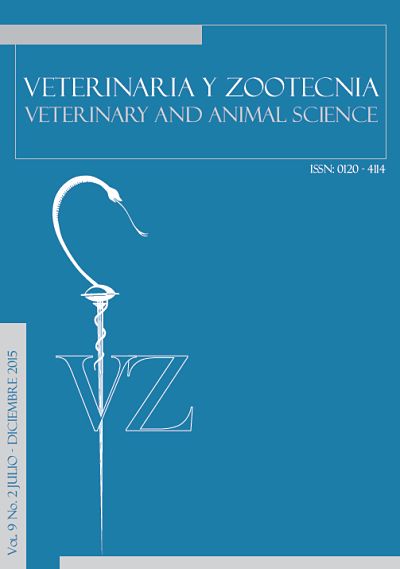Authors
Abstract
The energy and thyroid metabolism were studied in obese adult canine vs. normal adult canine. Fasting serum from 80 adult canines was obtained (40 obese canines older than one year and 40 normal canines older than one year). The levels of thyrotropin (TSH) and free thyroxine (T4L) were determined by enzyme immunoassay. The total cholesterol (TC), triglycerides (TAG) and HDL cholesterol (HDL-C) values were determined by enzymatic-colorimetric methods. The levels of LDL cholesterol (LDL-C) were obtained by the direct method and those of VLDL cholesterol (VLDL-C) were obtained with the Friedewald formula (TAG/5). The mean values of TSH (μUI/ml), T4L (ng/dl), CT (mg/dl), TAG (mg/dl), HDL-C and LDL-C (mg/dl) for obese adult canines were: 1.04; 1.05; 242.44; 58.82; 162.9; 11.75; 71.68, respectively. For the normal adult canines, the mean values were: 1.27; 0.93; 201.49; 37.57; 134.94; 7.42; 49.34, respectively. No significant difference was found in the levels of TSH and T4L in adult obese canines vs. normal adult canines (P-value: 0.51; 0.26, respectively). A significant difference was observed for the lipid profile. No significant difference was observed when comparing male/female canines with 95% reliability. In conclusion, the lipid profile is clearly altered in obese canines. Regarding the thyroid profile, no significant differences were found, although some author mention that fatty tissue affects this profile.
Keywords
References
Burkholder, W.J.; Toll, P.W. Obesity. In: Hand, M.S.; Thatcher, C.D.; Remillard, R.L.; Roudebush, P. (Ed). Small Animal Clinical Nutrition. Marceline, MO: Walsworth Publishing Co., 2000. p.404-406.
Dekelbab, B.H.; Abou Ouf, H.A.; Jain, I. Prevalence of Elevated Thyroid-Stimulating hormone levels in obese children and adolescents. Endocrine Practice, v.16, n.2, p.187-190, 2010.
Eirmann, L.A.; Freeman, L.M.; Laflamme, D.P. et al. Comparativa de adipokine concentraciones y los marcadores de inflamación en pacientes obesos versus perros de lean. Intern J Appl Res Vet Med, v.7, n.4, p.196-205, 2009.
Fettman, M.J.; Stanton, C.A.; Banks, L.L. et al. Effects of neutering on bodyweight, metabolic rate and glucose tolerance in domestic cats. Res Vet ScienK, v.62, p.131- 136, 1997.
Kahn, B.B.; Flier, J.S. Obesity and insulin resistance. The Journal of Clinical Investigation, v.106, p.473-481, 2000.
Kuruvilla, A.; Frankel, T.L. Heart rate of pet dogs: effects of overweight and exercise.Asia Pacifi c J Clin Nutr, v.12, p.51, 2003.
Lewis, G.F.; Carpentier, A.; Adeli, K. Disordered fat storage and mobilization in the pathogenesis of insulin resistance and type 2 diabetes. Endocrine Reviews, v.23, p.201- 229, 2002.
López-Pompey, N.A. Asociación entre el estado de la función tiroidea, parámetros metabólicos, niveles de anticuerpos anti tiroperoxidasa y los niveles séricos de la Adipocitoquina chemerin. Bogotá, Colombia: Universidad Nacional de Colombia, 2012. Tesis (Especialista en Endocrinología).
Marca, M.C.; Loste, A.; Sanz, M.C. et al. Hipotirodismo canino: Revision y actualización de su diagnostic. Avepal, v.16, n.3, p.111-117, 1996.
Matamoros, R.; Gómez, C.; Andaur, M. Hormonas de utilidad diagnóstica en Medicina Veterinaria. Arch med vet, v.34, n.2, p.167-182, 2002.
Mehmet, B.; Fulya, A.; Esma, A. et al. Obesity is associated with increased serum TSH level, independent of thyroid function. Swiss Med Wkly, v.137, p.431-434, 2007.
Melián-Limiñana, C.; Morales-Doreste, M.; Pérez-Alenza, M.D. Concentración de TSH endógena: un nuevo test para el diagnóstico de hipotiroidismo canino. Clínica Veterinaria de Pequeños Animales (Avepa), v.19, n.2, p.71-75, 1999.
Osorio, J.H.; Giraldo, C.E. Perfil lipídico en caninos adultos obesos vs caninos adultos normales. Revista Veterinaria y Zootecnia de Caldas, v.11, n.1, p.7-10, 1999.
Osorio, J.H.; Suárez, Y.J.; Pérez, J.E. Estudio del perfil lipídico canino por edad y sexo. Rev Med Vet, v.23, p.65-72, 2012a.
Osorio, J.H.; Vinazco, J.; Pérez, J.E. Comparación de perfil lipídico por sexo y edad en bovinos. Biosalud, v.11, n.1, p.25-33, 2012b.
Peña, C.; Suárez, L.; Bautista, I. et al. Relationship between analytic values and canine obesity. J Anim Physiol Anim Nutr (Berl), v.92, n.3, p.324-325, 2008.
Pibot, P.; Biourge, V.; Elliott, D. Enciclopedia de la nutrición clínica canina. Royal Canin. Paris: Aniwa Pub, 2008, p.509.
Ramírez-Benavides, G.F.; Osorio, J.H. Niveles séricos de Tetrayodotironina libre (T4L), Mediante el método de electroquimioluminiscencia en caninos. RC FCV-LUZ, v.19, n.3, p.238-241, 2009.
Ramsey, L.K.; Evans, H.; Herrtage, M.E. Thyroid stimulating hormone and total thyroxine concentrations in euthyroid, sick euthyroid and hypothyroid dogs. J Small Anim Pract, v.38, p.540-545, 1997.
Rochon, C.; Tauveron, I.; Dejax, C. et al. Response of glucose disposal to hyperinsulinaemia in human hypothyroidism and hyperthyroidism. Clinical Science, v.104, p.7-15, 2003.
Rojas-Gabulli, M.I.; Núñez, O.; Del Águila, C. et al. Resistencia a insulin en adolescents obesos. An Fac Med, v.71, n.1, p.13-20, 2010.
Samaan, S.H. Niveles de hormona estimulante de tiroides en niños obesos sin patologia tiroidea. Rev Horiz Med, v.14, n.4, p.23-28, 2012.
Tams, T.R. Manual de gastroenterología en pequeños animales. 2nd ed. Buenos Aires: Inter-Médica, 2004. 438p.
Veiga, A.P.; Price, C.A.; De Oliveira, S.T. et al. Association of canine obesity with reduced serum levels of C-reactive protein. J Vet Diagn Invest, v.20, n.2, p.224-228, 2008.
Zentek, J.; Elices, R.; Goodar, F. et al. Obesidad en perros y gatos: Implicaciones dietéticas. Rev Canis et felis, v.106, p.6-19, 2010.

 pdf (Español (España))
pdf (Español (España))
 FLIP
FLIP














